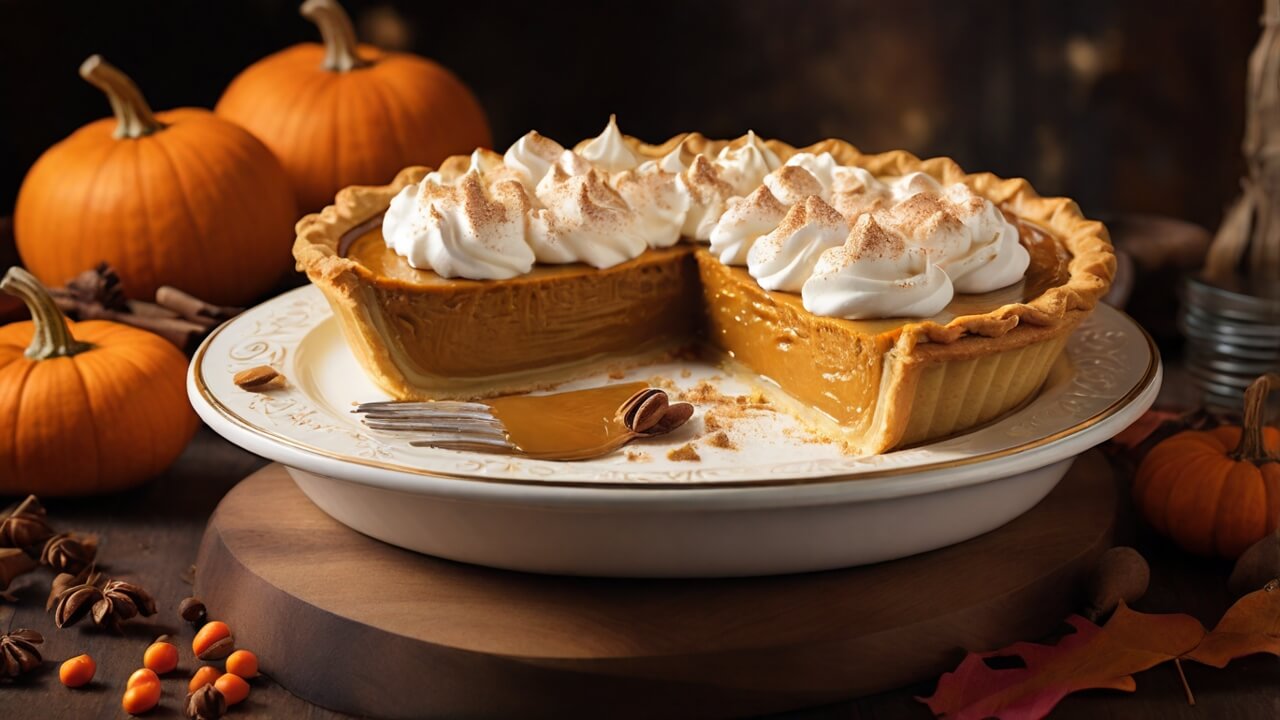In the annals of American culinary history, few names shine as brightly as Amelia Simmons. Published in 1796, her seminal work, American Cookery, stands as the first truly American cookbook, a groundbreaking compilation of recipes that captured the essence of the young nation’s diverse culinary landscape.
Among the many treasures found within its pages is a recipe for pumpkin pie – a dessert that would become an enduring symbol of American cuisine.
Simmons’ version, however, differed significantly from the pumpkin pies we know today. Hers was a custard-like creation, enriched with molasses and spices, offering a unique taste experience that harkened back to the colonial era.
This 1796 pumpkin pie recipe represents more than just a historical curiosity; it is a culinary time capsule, preserving the flavors and techniques of early American kitchens.
By recreating this authentic recipe, we can gain a deeper appreciation for the ingenuity and resourcefulness of our culinary forebears, and connect with a rich heritage that has shaped the way we eat and bake today.
The Origins of Pumpkin Pie
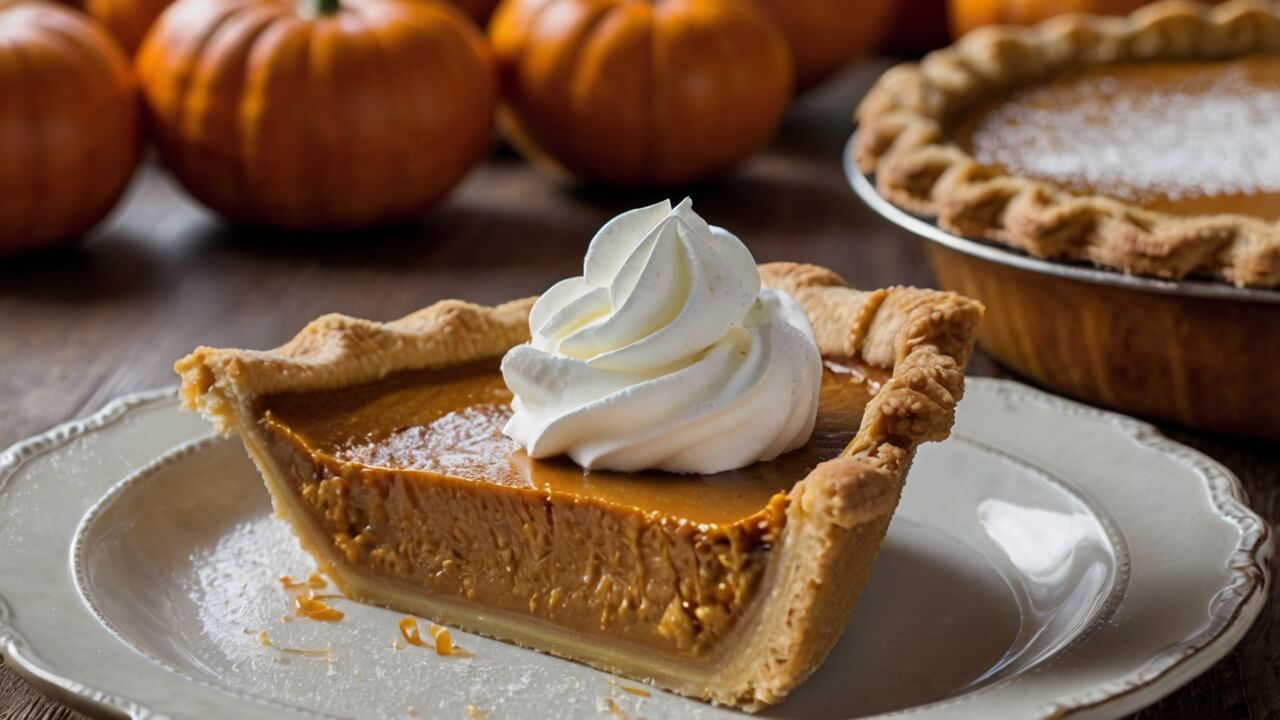
Pumpkin pie has become an iconic dessert in American cuisine, deeply rooted in the nation’s history and traditions. Its origins can be traced back to the early colonial era when pumpkins, introduced by Native Americans, became a staple crop for European settlers.
The first recorded pumpkin pie recipe dates back to 1675, found in a British cookbook entitled “The Compleat Cook.” However, it was the indigenous peoples of North America who first recognized the culinary potential of pumpkins, using them in various dishes long before the arrival of Europeans.
As the colonies grew and thrived, pumpkin pie evolved into a beloved treat, particularly during the autumn harvest season. The abundance of pumpkins and the necessity for resourcefulness in the harsh New World climate made this dessert a practical and comforting choice for early American households.
Over time, the recipe for pumpkin pie underwent several transformations. Early versions often featured a custard-like filling made from pumpkin puree, eggs, and spices like cinnamon, ginger, and nutmeg. Molasses or maple syrup were commonly used as sweeteners, lending a distinct, rich flavor.
As the availability of ingredients improved and tastes evolved, pumpkin pie recipes began incorporating more familiar ingredients like granulated sugar and cow’s milk, moving away from the original molasses-based fillings. The introduction of pre-made pie crusts and canned pumpkin puree also made the process more convenient.
Despite these changes, pumpkin pie remained a beloved tradition, especially during the Thanksgiving holiday. Its connection to the harvest season and the perseverance of early American settlers solidified its status as a quintessential piece of Americana.
The 1796 Pumpkin Pie Recipe
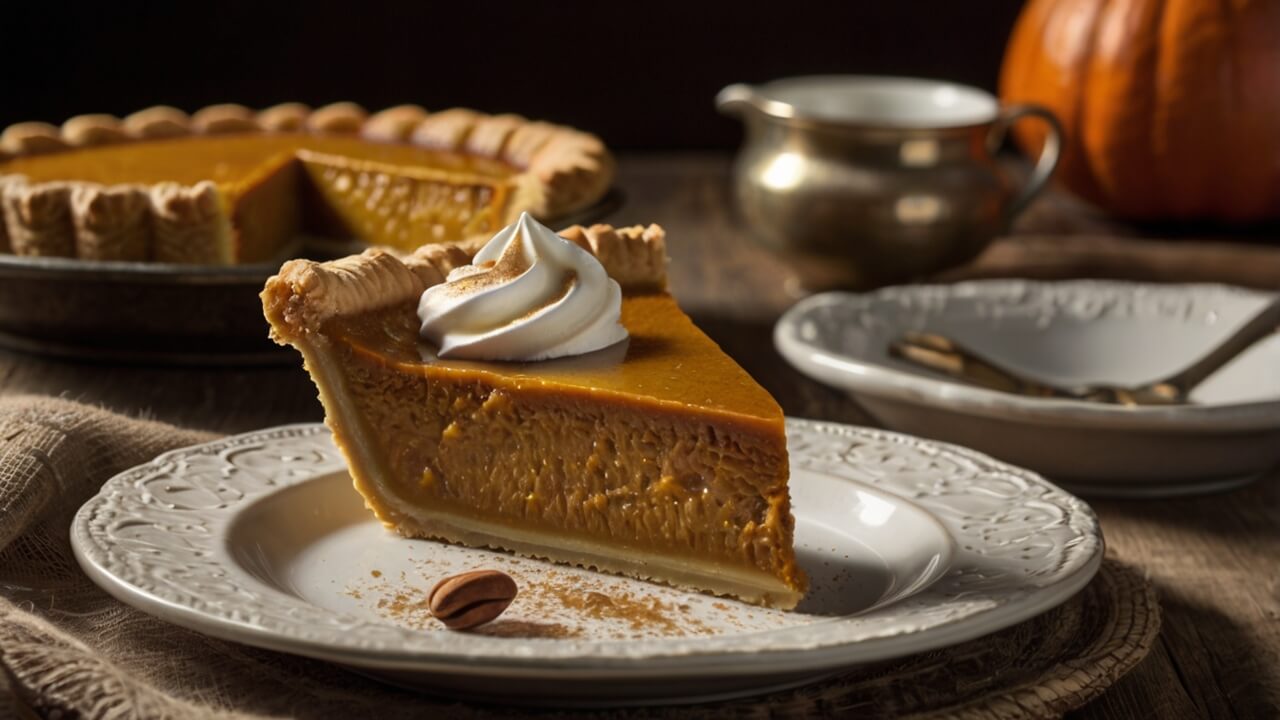
Amelia Simmons’ 1796 pumpkin pie recipe stands out from modern versions due to its unique ingredients and preparation method. Unlike the dense, heavily spiced pumpkin pies we’re accustomed to today, Simmons’ recipe yields a delicate, custard-like filling with a distinct molasses flavor.
The use of molasses, rather than refined sugar, was common in early American cooking and lent a deep, rich sweetness to baked goods. Simmons’ recipe calls for a generous amount of molasses, which would have been readily available and affordable for households at the time.
Another notable difference is the absence of spices like cinnamon, ginger, and nutmeg, which have become integral to modern pumpkin pie recipes. Instead, the 1796 version relies solely on the natural flavors of pumpkin, molasses, and eggs, creating a pure, unadulterated taste of early American cuisine.
The custard-like texture results from the high proportion of eggs and cream used in the filling. Rather than the dense, almost bread-like consistency of today’s pumpkin pies, Simmons’ recipe produces a silky, pourable filling that sets into a delicate, creamy custard when baked.
Ingredients and Their History

Pumpkin: The pumpkin, a quintessential ingredient in American cuisine, has been cultivated by Native Americans for centuries. The variety used in the 1796 recipe was likely a smaller, sweeter pumpkin variety, distinct from the larger pumpkins we use today for carving jack-o’-lanterns.
Molasses: Molasses, a thick, dark syrup derived from sugarcane, was a common sweetener in early American cooking. It added a rich, robust flavor to the pumpkin pie filling, contrasting with the more refined white sugar used in modern recipes.
Eggs: Eggs were a crucial ingredient in the custard-like filling of the 1796 pumpkin pie. They provided structure and richness, creating a denser, more velvety texture than today’s pies.
Cream: Fresh cream, a luxury in the 18th century, was likely used sparingly in the original recipe. It added a delicate richness and creaminess to the filling.
Spices: The warm, aromatic blend of spices, including ginger, cinnamon, and nutmeg, was a hallmark of early American pumpkin pies. These spices were imported from the West Indies and added depth and complexity to the flavors.
Crust: The crust was likely made from a simple mixture of flour, butter, and water, without the addition of modern ingredients like shortening or sugar. This created a more rustic, flaky crust that complemented the rich filling.
Each ingredient in the 1796 pumpkin pie recipe holds a unique place in American culinary history, reflecting the resourcefulness and creativity of early settlers in utilizing the bounty of the New World.
Traditional Preparation Methods
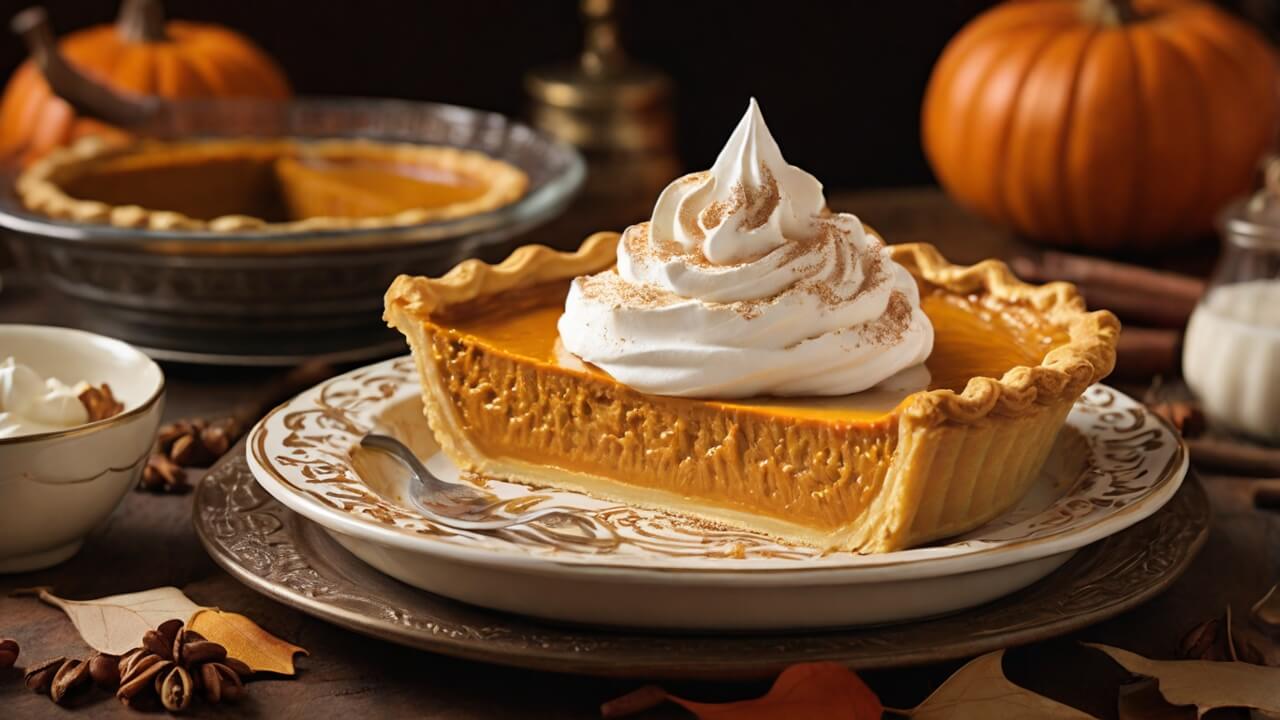
In 1796, baking pumpkin pie involved a labor-intensive process that required patience and skill. Amelia Simmons’ recipe calls for traditional techniques that were common in early American kitchens.
To begin, you’ll need to procure a fresh pumpkin or squash, ideally a variety like the cheese pumpkin or Boston marrow, which were popular in Simmons’ time. Cut the pumpkin in half, scoop out the seeds and stringy pulp, and bake the halves until tender. Once cooled, scrape the flesh from the skin and mash it into a smooth puree.
Next, prepare the spice mixture by grinding together cinnamon, ginger, and nutmeg using a mortar and pestle. This aromatic blend, known as “pumpkin pie spice,” was a staple in colonial kitchens and added warmth and depth to the filling.
In a separate bowl, combine the pumpkin puree with molasses, a common sweetener in early American cooking. Simmons’ recipe calls for a generous amount of molasses, which imparts a rich, complex flavor that sets this pie apart from modern versions.
To create the custard-like filling, crack fresh eggs into the pumpkin mixture and whisk vigorously until well combined. This step requires some elbow grease, as electric mixers were not yet invented.
Finally, gently fold in the spice mixture, taking care not to overmix. The result should be a smooth, fragrant filling with a deep orange hue from the pumpkin and molasses.
Baking the 1796 Pie
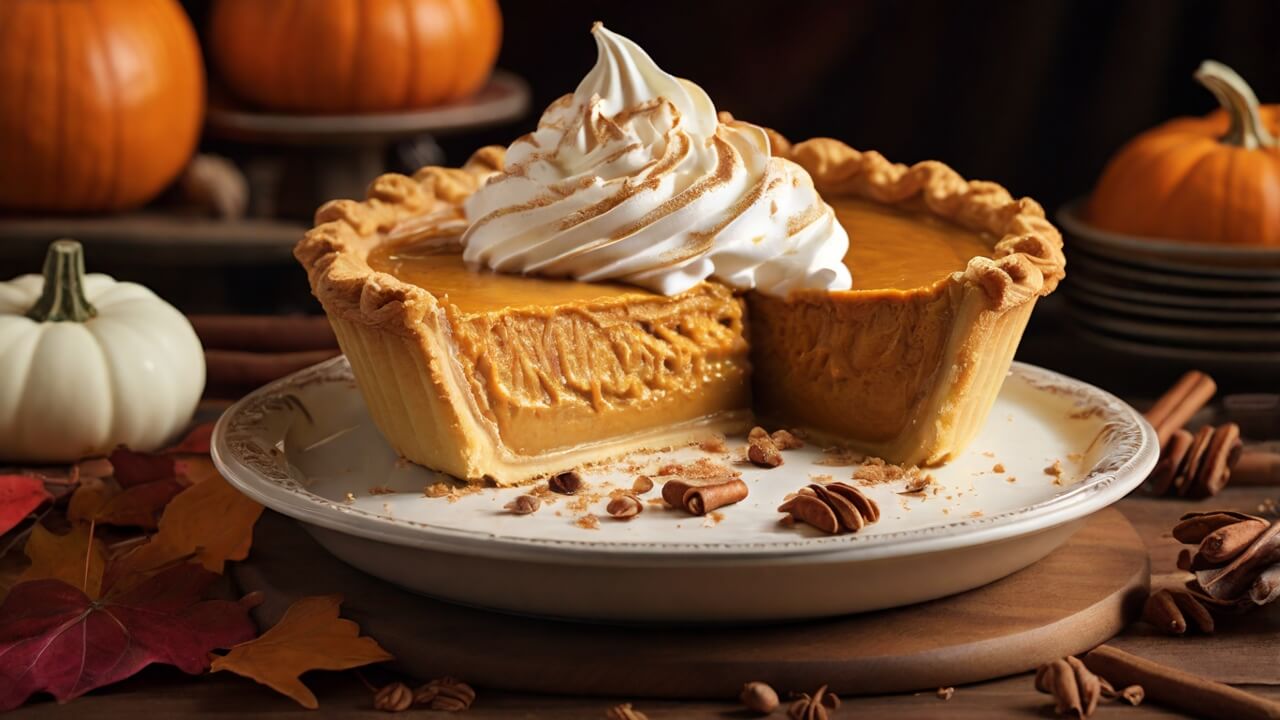
To recreate the authentic 1796 pumpkin pie, special care must be taken in preparing both the crust and the custard-like filling. Let’s delve into the intricate details.
The Crust
Simmons’ recipe calls for a straightforward pie crust made with just flour, shortening (likely lard or butter), and water. The key is achieving the perfect texture through proper mixing and handling of the dough.
- In a large bowl, cut the shortening into the flour using a pastry blender or two forks until the mixture resembles coarse crumbs.
- Gradually add ice-cold water, a tablespoon at a time, and mix gently until the dough just comes together, being careful not to overwork it.
- Form the dough into a disk, wrap it in parchment paper or plastic wrap, and refrigerate for at least 30 minutes to allow the gluten to relax.
- On a lightly floured surface, roll out the chilled dough to a 12-inch circle, about 1/8-inch thick.
- Carefully transfer the dough to a 9-inch pie plate, gently pressing it into the bottom and sides, and trimming any excess dough from the edges.
- Blind Bake: To achieve a perfectly flaky and crisp crust, it’s essential to blind bake (prebake) the crust before adding the filling. Line the crust with parchment paper or foil, and fill it with pie weights, dried beans, or rice. Bake at 400°F (205°C) for 15 minutes, then remove the weights and liner, and bake for an additional 5-7 minutes until the crust is lightly golden.
The Filling
Simmons’ pumpkin pie filling is a unique blend of pumpkin puree, molasses, and warm spices, resulting in a rich, custard-like texture.
- In a large bowl, whisk together the pumpkin puree, molasses, cream or milk, eggs, and spices (ginger, cinnamon, and nutmeg) until well combined and smooth.
- Pour the filling into the blind-baked pie crust, being careful not to overfill.
- Bake at 350°F (175°C) for 45-55 minutes, or until the center is set but still slightly jiggly.
- Cooling: Allow the pie to cool completely on a wire rack before slicing and serving. This cooling process is crucial for the filling to set properly.
Tips for Success
- Use fresh, high-quality ingredients for the best flavor.
- Roast and puree your own pumpkin for an even richer taste.
- Adjust the spice levels to suit your personal preferences.
- Tent the pie with foil if the crust is browning too quickly.
- Let the pie cool completely before slicing to prevent a soggy crust.
- Serve at room temperature or slightly chilled, with a dollop of freshly whipped cream if desired.
By following these traditional methods and paying close attention to detail, you’ll be rewarded with an authentic 1796 pumpkin pie that transports you back in time with every delicious bite.
Tasting Notes
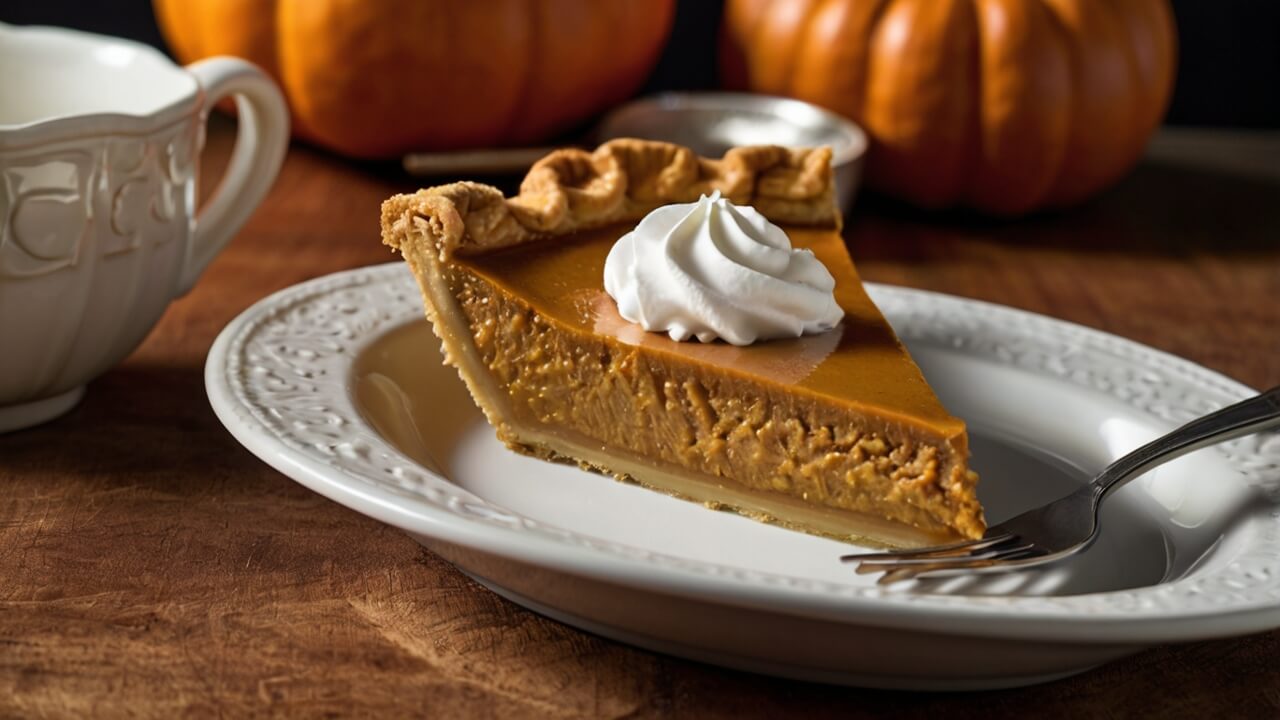
The 1796 pumpkin pie boasts a flavor profile that is both familiar and delightfully distinct from its modern counterparts. The custard-like filling, enriched with molasses, offers a depth of flavor that is warm, subtly spiced, and undeniably comforting.
Upon taking the first bite, the velvety texture of the filling envelops the palate, its richness a testament to the simplicity of the ingredients used. The molasses lends a unique caramelized note, complementing the natural sweetness of the pumpkin without overpowering it.
Unlike contemporary pumpkin pies, which often rely heavily on spices like cinnamon and nutmeg, the 1796 recipe allows the pumpkin’s inherent flavor to shine through. The subtle warmth of the spices used, such as ginger and allspice, enhances the pumpkin’s earthiness without dominating the overall taste.
The crust, made with just a few simple ingredients, provides a delightful contrast to the luscious filling. Its flaky texture and buttery taste create a perfect harmony with the velvety custard, ensuring each bite is a delightful balance of flavors and textures.
Overall, the 1796 pumpkin pie offers a unique and authentic taste experience that transports the senses back in time. Its rich, comforting flavors and historical significance make it a true culinary treasure worth savoring.
Comparison to Modern Recipes
The 1796 pumpkin pie recipe stands in stark contrast to the pumpkin pies we’re familiar with today. While modern recipes rely heavily on spices like cinnamon, ginger, and nutmeg to provide warmth and depth of flavor, the 1796 version derives its rich taste from the molasses and the natural sweetness of the pumpkin itself.
Another notable difference is the texture. Contemporary pumpkin pies often have a dense, custardy filling achieved through the use of eggs and evaporated milk. In contrast, the 1796 recipe yields a lighter, more delicate filling with a consistency akin to a silky pumpkin purée.
The crust also sets this historical pie apart. Rather than the flaky, buttery crusts we’ve grown accustomed to, the 1796 recipe calls for a simple, sturdy pastry dough made with just flour, water, and a touch of butter or lard. This crust serves as a humble vessel to showcase the pure, unadulterated flavors of the pumpkin filling.
While modern pumpkin pies are often adorned with whipped cream or dusted with spices, the 1796 version is presented in its most natural form, allowing the true essence of the pumpkin to shine through. This simplicity is a testament to the resourcefulness and ingenuity of early American cooks, who crafted delicious desserts from humble, locally sourced ingredients.
The Historical Significance
The 1796 pumpkin pie recipe from Amelia Simmons’ American Cookery holds a significant place in the culinary heritage of the United States. This recipe represents a pivotal moment in the evolution of American cuisine, as it showcased the ingenious adaptations made by early settlers to create dishes using locally available ingredients.
Pumpkins, a staple crop among Native Americans, were embraced by the European colonists and quickly became a beloved ingredient in various dishes, including the iconic pumpkin pie. Simmons’ recipe stands out as one of the earliest documented versions of this quintessential American dessert, capturing the resourcefulness and creativity of early American cooks.
Beyond its historical relevance, the 1796 pumpkin pie offers a unique and captivating taste experience. Unlike modern versions that often rely heavily on spices and sweeteners, this recipe showcases the natural flavors of pumpkin and molasses, resulting in a rich, custard-like filling with a depth of flavor that is both comforting and intriguing.
The use of molasses, a byproduct of sugar production, adds a distinct complexity and robustness to the pie, hinting at the resourcefulness of early American cooks who sought to make the most of available ingredients. The custard-like texture, achieved through careful preparation and baking, creates a velvety mouthfeel that is a departure from the denser, more heavily spiced pumpkin pies of today.
By recreating this historic recipe, one not only gains insight into the culinary traditions of early America but also connects with the ingenuity and resilience of those who paved the way for the diverse and vibrant food culture we enjoy today. Tasting the 1796 pumpkin pie is a journey through time, a celebration of the enduring spirit of American cuisine, and a reminder of the rich tapestry of flavors that have been woven into the fabric of our nation’s culinary identity.
Try It Yourself
Immerse yourself in a piece of culinary history by recreating the authentic 1796 pumpkin pie recipe. This is your chance to experience the rich, molasses-infused flavors and velvety custard texture that delighted early Americans. Don’t let this unique taste of the past slip away – take on the challenge of baking this historical delight in your own kitchen.
Once you’ve savored the first bite of your homemade 1796 pumpkin pie, share your experience with others! Use the hashtag #1796PumpkinPie on social media to showcase your baking prowess and connect with fellow culinary adventurers. Describe the flavors, textures, and any challenges you encountered along the way. Your post could inspire others to embark on this delicious journey through time.
Crafting this historical treasure is an opportunity to appreciate the ingenuity and resourcefulness of early American cooks. Embrace the traditional techniques, savor the distinct taste, and revel in the sense of connection to our culinary roots. Don’t let this authentic recipe remain a relic of the past – bring it to life in your home and share the experience with others.
Explore More Historical Recipes
After trying your hand at the authentic 1796 pumpkin pie recipe, why not continue your culinary journey through history? Share your baking experience and results on social media using the hashtag #1796PumpkinPie. We’d love to see your creations and hear about the flavors and textures you encountered.
But don’t stop there! Delve deeper into the rich tapestry of American culinary heritage by exploring our collection of historical recipes. From colonial-era breads and stews to 19th-century desserts and preserves, you’ll find a treasure trove of authentic recipes that offer a taste of the past.
Immerse yourself in the stories behind these recipes, and experience the flavors that graced the tables of generations before us. Who knows? You might just discover a new favorite dish that’s been waiting centuries to be rediscovered.
So, grab your apron, fire up your oven, and let’s embark on a flavorful adventure through time together!

